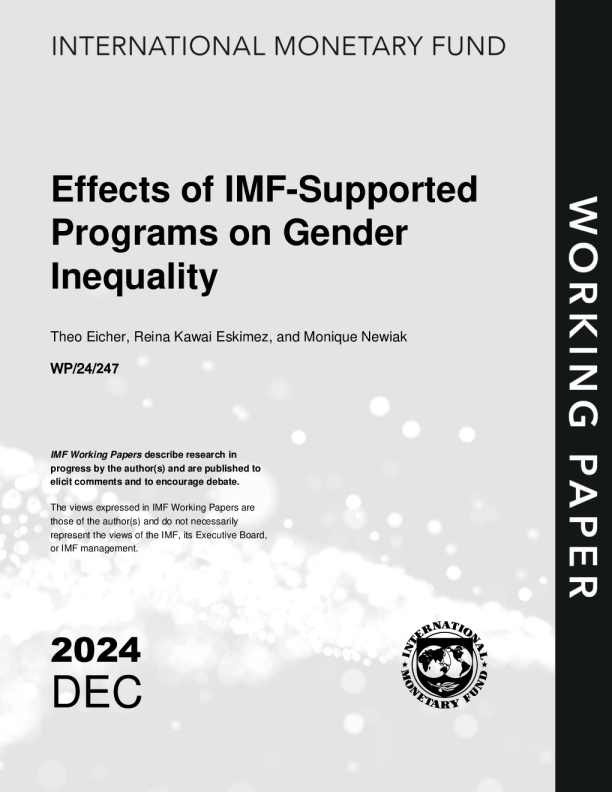国际货币基金组织支持的低收入国家项目:脆弱国家与非脆弱国家2024
 AI智能总结
AI智能总结
低收入国家中受国际货币基金组织支持的项目:脆弱国家与非脆弱国家 蔡凯豪,马丁·埃杜阿尔,以及费利克斯·瓦迪WP/24/221 国际货币基金组织工作描论述文研究作者(们)的进步,并已发表至引发评论并鼓励辩论。 国际货币基金组织工作论文中表达的观点作者(们)的,不一定 代表国际货币基金组织(IMF)及其执行董事会的观点或国际货币基金组织的管理层。 2024 OCT ©2024国际货币基金组织WP/24/221 国际货币基金组织工作论文非洲部门 国际货币基金组织支持的低收入国家计划:脆弱国家与非脆弱国家,由蔡凯豪、马丁·爱德华和瓦尔德·费利克斯编写 由查拉朗布斯·桑加里迪斯授权分发,2024年10月 MF工作论文 我描述作者(们)正在进行的研究,并发布以征求评论并鼓励辩论。国际货币基金组织(IMF)工作论文中表达的观点为作者(们)的个人观点,并不一定代表IMF、其执行董事会或IMF管理层的观点。 摘要:本文探讨了2009年至2022年间国际货币基金组织(IMF)支持的低收入国家的宏观经济框架,重点关注宏观经济目标和其实现情况在脆弱国家和冲突影响国家(FCS)与非FCS之间的差异。主要发现包括FCS和非FCS具有相似的项目目标,除了通货膨胀外,所有考虑的维度都表现出乐观态度,以及目标和结果之间没有显著的相关性。对于通货膨胀以外的变量,与项目预测相比,等于其他项目平均或中位数结果的独立国家目标作为实际结果预测者的表现更佳。在IMF支持的项目中设定现实、具体国家和项目目标所面临的挑战。 这强调了低收入国家的项目。最后,我们讨论了潜在的警告,包括GDP重新基准化、初始条件和目标之间的非线性关系以及重复项目。我们未研究因果关系,也不对此提出任何主张。 推荐引用格式:蔡,凯豪,埃杜阿尔·马丁,费利克斯·瓦迪。2024。《低收入国家国际货币基金组织支持的计划:脆弱国家与非脆弱国家》。国际货币基金组织工作论文WP/24/221。 JEL分类号: F33,F34,F35,O11,O19. 关键词: 国际货币基金组织项目;贷款机构;脆弱性;定制;乐观 作者电子邮件地址: kcai@imf.org,emartin@imf.org,fvardy@imf.org 工作论文 国际货币基金组织支持的低收入国家计划:脆弱国家与非脆弱国家 由蔡凯豪、马丁·埃杜亚尔和费利克斯准备PVárdy1 1作者们欲对以下人士表示感谢,但不涉及具体责任:SeverCan、AlionaCebotari、MaxDovì、MaiFarid、ChrisHinchcl 、FrankHespeler、CarlosvanHombeeck、DaehaengKim、VitaliyKramarenko、TohKuan、TomoMineyama、MicoMrkaic 、ChrisPapageorgiou、LucaRicci、AxelSchimmelpfennig、HarisTsangarides、OlafUnteroberdoerster、IssoufSamake,以及国际货币基金组织(IMF)的研讨会参与者,感谢他们的评论和建议。RobertaGuarnieri提供了出色的研究协助。感谢JoannaDelcambre在稿件编辑方面的支持。 目录 I.引言4 主要发现.4文 献综述.5 第二部分:问题、方法与数据.6 研究问题.6研究方法. ..................................................................................................................................................6数据来源..... ...........................................................................................................................................10 第三部分定量定制12 绝对野心12相对野 心14 第四章乐观17 V.目标与成果之间✁相关性.21 VI.注意事项.27 第七部分结论29 参考文献.31 附录A.初➓条件与目标.33 附录B.中位数而非平均值.35 附录C.排除受COVID影响✁项目.38 附录D.包含负面调整内容.44 附录E.初次与重复项目47 附录F.增长乐观程度能解释多少?.52 附录G.国内生产总值重新基准化.55 附录H.国家分类.56 数字 1.程序批准日期直方图7 2.样本内程序持续时间直方图.8 3.初➓条件与目标增长比较.15 4.目标与成果对比.21 5.重复客户:程序批准之间的时间29 表格 1.变量.10 2.绝对雄心.13 3.相对雄心.16 4.乐观主义.19 5.乐观主义—仅按计划进行.20 6.相关系数.24 7.相关系数—仅按计划进行.25 I.引言 本文研究了国际货币基金组织(IMF)支持的低收入国家(LICs)的宏观经济框架,考察了宏观经济目标和实现情况在脆弱和冲突影响国家(FCS)与非FCS的项目之间有何不同。IMF将其191个成员国中约五分之一指定为FCS。其中大多数也是LICs。3相反,几乎一半的次区域信用机构(LICs)属于FCS(例如,参见IMF,2022年)。在这里,我们只考虑可能是或不可能是FCS的LICs。FCS拥有近十亿人口,他们面临着长期挑战,如薄弱的政府机构、有限的公共服务以及持续的冲突。脆弱性和冲突严重影响了经济稳定,干扰了国际收支、贸易和金融流动,同时也阻碍了经济发展()。同上。). 我们的比较研究涵盖了2009年至2022年期间,部分受到最近国际货币基金组织(IMF)对脆弱国家冲突环境战略建议的启发,该建议呼吁更好地“定制”IMF与脆弱国家冲突环境的接触。该战略于2022年启动。然而,对IMF支持的项目进行定制的呼声至少可以追溯到2008年,当时IMF发布了其关于脆弱国家和后冲突国家经验的第一份审查。尽管定制有许多维度,但一个重要的元素是“避免过度乐观的假设”并应用“更加现实的宏观框架”(参见,例如,IMF,2008,2011,2015,2022,以及独立评估办公室(IEO),2018)。我们将这一方面称为“定量定制”,这也是当前论文的重点。 我们试图评估定量定制程度的范围,即嵌入在IMF支持项目宏观框架中的目标。我们还研究了乐观程度以及目标与结果之间的关联程度。以往关于定制的论文主要关注项目设计中的差异,或差异的缺乏(例如,先前行动的数量和种类、量化绩效标准以及结构基准),而不是关注宏观经济变量预测的潜在差异。这些变量是本文的重点。它们包括增长、通货膨胀、财政巩固和外部调整变量。在这种情况下,乐观程度是指预测与结果之间的差异,而关联程度是指两者之间的关联度。 本文中,我们将术语“项目目标”、“预测”和“目标”互换使用。目标、预测和目标均指在项目批准时从IMF支持的项目的宏观框架中提取的三年定量预测。这些变量并非必须满足的正式绩效标准,以使IMF融资得以发放。相反,它们反映了IMF工作人员对于在项目下经济将如何发展的预期。虽然目标可能会在项目期间进行调整,但我们关注它们的原始值。 主要发现 我们的主要发现如下: 有限数量的定制:项目目标在FCS和非FCS的LICs之间似乎没有显著差异,无论是从绝对值来看还是相对于初始条件而言。 目标往往在其他所有维度上都会missed,除了通货膨胀。 相当乐观:4 2遵循国际货币基金组织(IMF)的普遍做法,我们认定如果一个国家符合IMF贫困减缓和增长信托(PRGT)的融资资格, 家就被视为一个低收入国家(LIC),而PRGT是IMF主要的优惠融资来源。关于低收入国家(LIC)以及金融合作特殊账户(FCS)的名单,请参见附录H。 4在按计划进行的项目中,除了通货膨胀和储备之外的所有维度都未能达到目标。 对于除了增长和通胀以外的变量,我们不能拒绝零假设。 弱相关性: 目标和结果在统计学上是独立的。与国家或项目无关的目标,如果等于所有其他项目的平均数或中位数结果,将优于项目预测,作为预测实际结果(除了通货膨胀以外的)维度的指标。 尽管对研究结果的成因进行推测很有趣,但我们故意避免因果关系的疑问。目标、结果、项目实施和其他可能具有解释性的变量的普遍内生性使得可信的识别变得艰巨。在没有合适的工具的情况下,我们倾向于在因果关系的疑问上保持中立。 本文的结构如下:引言的剩余部分简要回顾了文献综述。第二节详细阐述了研究问题、方法和数据。第三至五节分别研究了量化定制、乐观主义以及目标与结果之间的相关性。第六节讨论了潜在的注意事项,而第七节得出结论。附录中包含额外的图表和表格,而数据和代码可在网上获取。 文献综述 虽然关于IMF支持的低收入国家(LICs)项目的文献相当丰富(例如,参见BalGunduz(2013)及其中的参考文献),但聚焦于IMF支持的与新兴市场国家(FCS)项目的研究却相对较少。值得注意的例外包括Kunduz(2018 )和Lane。等人(2021),和Collyns等人(2021)该研究基于国际货币基金组织独立评估办公室关于《国际货币基金组织与脆弱国家》(IEO,2018)的报告。这些研究突出指出:(i)从国际货币基金组织借款的金融稳定委员会(FSC)低收入债务国的借款频率类似于非FSC低收入债务国;(ii)然而,与FSC贷款计划相关的完成率明显较低——30%与75%相比;(iii)从先前行动的数量和性质、定量业绩指标和结构标准的角度来看,金融稳定委员会和非金融稳定委员会之间的条件水平差异不大。 尽管大多数研究集中在IMF支持的项目设计上,Kunduz(2018)评估了宏观经济成果——特别是援助流动和增长。他指出,与FCS相比,IMF支持的项目对官方发展援助有积极影响。他还发现FCS中存在更多的波动性和略微较低的增长成果——这也是我们确认的。最后,他展示了FCS项目批准后,增长往往增加约一个百分点(p.p.)。 关于乐观主义,我们的研究与Kim的关系最为紧密。等人(2021)此处所呈现的程序设计中乐观主义的证据与Kim之前的研究总体上是一致的。等人他们将GRA和PRGT项目并置,特别关注增长和财政乘数。我们专注于PRGT,并将其分为FCS和非FCS。由于时间的推移,我们的数据集受益于一个相对较长的时序范围,为我们提供了大约三年的额外数据。在IMF支持的计划中,关于乐观主义的重要早期工作包括Baqr。等人(2005a,2005b)。 关于目标和结果的相关性,我们的论文与Celasun相关。等人(2021).Celasun等人 评估2004年至2017年WEO增长预测的准确性。他们发现短期实际GDP增长预测显示最小的偏差。然而,长期WEO增长预测(两年至五年前)往往过于乐观,并且在许多情况下,不如基于最近过去平均增长率的简单预测准确。我们在一个项目背景下重复了这一发现,并将其扩展到除增长以外的其他变量。 在IMF支持的项目范围之外,关于经济表现与脆弱性之间关系的文献非常丰富(例如,参见Leepipatpiboon )。等众多作者.,2023,andreferencestherein).Leepipatpiboon等众多作者区分该文献中的两种静脉 ,根据因果关系的方向: 第一项研究探讨了脆弱性和冲突对经济表现✁负面影响。这种负面影响通过各种渠道传递,包括加剧经济不确定性、恶化✁财政平衡、消费减少以及实物资本✁恶化和破坏,如Collier(1999)、Rodrik(1999)、CerraandSaxena(2008)等人✁作品中所示。此外,文献指出,脆弱性和冲突对周边国家✁经济产生了负面✁溢出效应,这 些效应受到诸如大量难民人口对基础设施和财政账户✁影响等挑战✁加剧,如Anselin和O’Loughli




